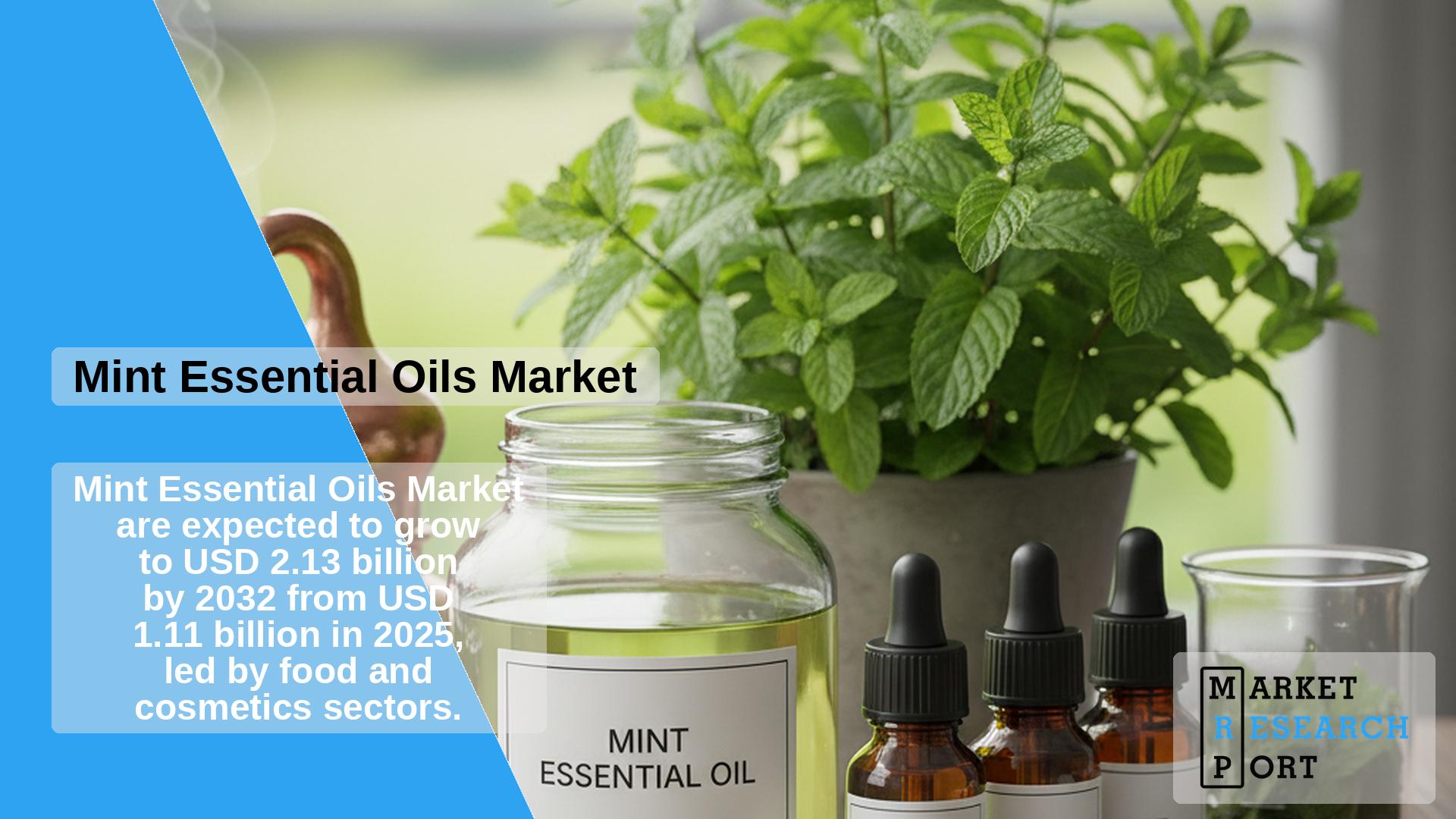
The global mint essential oils market achieved a value of USD 1.24 billion in 2025 and is expected to reach USD 2.05 billion by 2030, growing at a CAGR of 10.2% during 2025–2030. Market growth is primarily driven by the rapid expansion of aromatherapy, cosmetics, food & beverage, and wellness industries. Advancements in extraction technology and the increasing popularity of natural products over synthetic alternatives are also driving production and adoption of mint-derived essential oils worldwide.
Mint essential oils are extensively used in relaxation-based therapies, including aromatherapy and spa treatments. They also find widespread application in personal care items such as soaps, toothpaste, hair care, and perfumes. Additionally, their flavoring and aromatic properties fuel demand across the confectionery, dairy, and beverage industries. Growing disposable incomes and a rising preference for natural, plant-based ingredients in developed markets like the U.S., Germany, and the U.K. continue to strengthen overall market penetration.
Furthermore, the increasing influence of social media and the wellness trend among the urban population has amplified interest in plant-extracted therapeutic oils. Mint essential oils, known for their cooling and healing properties, have become essential components in relaxation and mood-enhancing treatments globally.
The spa and relaxation segment maintained dominance in 2025, accounting for approximately 43.8% of total revenue and is projected to grow at a CAGR of 10.8% through 2030. Mint essential oils are used extensively in cosmetics and personal care formulations for their soothing aroma and refreshing qualities. Rising consumer interest toward holistic beauty products and aromatherapy-integrated wellness routines has further elevated their importance in this category.
Mint oils also play a vital role in hygiene and cleaning applications, particularly in baby care, oral hygiene, and hair care. Their antibacterial and antioxidant benefits make them an increasingly popular choice in natural formulations. Meanwhile, the food and beverages segment continues to gain traction as mint oils are preferred for flavor infusion and taste enhancement in beverages, baked goods, and confectionery. Their antioxidant and digestive benefits have further expanded their usage in health drinks and functional foods.
Europe remained the leading regional market in 2025, accounting for 38.6% of total revenue, due to its robust personal care, fragrance, and pharmaceutical industries. Growing demand for naturally sourced components and clean-label ingredients has significantly increased the adoption of mint essential oils. Regulatory frameworks encouraging sustainable production practices and consumer preference for herbal ingredients further accelerate regional growth.
North America registered the fastest growth rate at a CAGR of 11.4%. Increasing awareness of aromatherapy’s stress-relief benefits and shifting preferences toward eco-friendly, plant-derived ingredients in home care and personal care products continue to drive consumption. The U.S. market, in particular, benefits from a large spa culture, wellness brand expansion, and significant integration of mint formulations in skincare and relaxation products.
Asia Pacific saw strong production growth—especially in India, China, and Japan—owing to abundant mint cultivation and expanding domestic processing capabilities. The region also benefits from growing exports supported by the increasing international demand for peppermint and spearmint oils. Rising disposable income and the growing popularity of organic consumer goods are further fueling the market in this region.
The global mint essential oils market is moderately consolidated with both multinational manufacturers and regional players focusing on competitive pricing, advanced extraction technology, and vertical integration to strengthen their supply chains. Key strategies include mergers, acquisitions, and product diversification aimed at meeting evolving consumer preferences for pure, sustainable, and high-quality aromatic oil products.
| Report Attribute | Details |
| Market size value in 2025 | USD 1.24 billion |
| Revenue forecast in 2030 | USD 2.05 billion |
| Growth rate | CAGR of 10.2% from 2025 to 2030 |
| Historical data | 2019–2024 |
| Forecast period | 2025–2030 |
| Quantitative units | Volume in tons, revenue in USD million, and CAGR from 2025 to 2030 |
| Report coverage | Market revenue forecast, company ranking, emerging trends, and competitive landscape analysis |
| Segments covered | Application, region |
| Regional scope | North America; Europe; Asia Pacific; Central & South America; Middle East & Africa |
| Country scope | U.S.; Canada; Mexico; UK; Germany; France; China; Japan; India; South Korea; Australia; Brazil; Argentina; Saudi Arabia; South Africa |
| Key companies profiled | H. Reynaud & Fils; FLAVEX Naturextrakte GmbH; India Essential Oils; Sydney Essential Oil Company; Moksha Lifestyle Products; Rocky Mountain Oils, LLC |
This report offers forecasts for volume and revenue at global, regional, and country levels and provides an analysis of the latest industry trends for different applications between 2019 and 2030.
How large is the mint essential oils market in 2025?
The market was valued at USD 1.24 billion in 2025.
What is the expected growth rate of the mint essential oils market?
The market is projected to grow at a CAGR of 10.2% between 2025 and 2030, reaching USD 2.05 billion by 2030.
Which application segment leads the market?
The spa and relaxation segment dominated the market with 43.8% share in 2025 owing to its strong presence in cosmetics, aromatherapy, and personal care applications.
Who are the leading players in the mint essential oils market?
Key companies include H. Reynaud & Fils, FLAVEX Naturextrakte GmbH, India Essential Oils, Sydney Essential Oil Company, Moksha Lifestyle Products, and Rocky Mountain Oils, LLC.
What factors are driving market growth?
The growth is primarily fueled by the expansion of aromatherapy and personal care industries, increased consumer inclination toward natural ingredients, and advancements in essential oil extraction technologies.